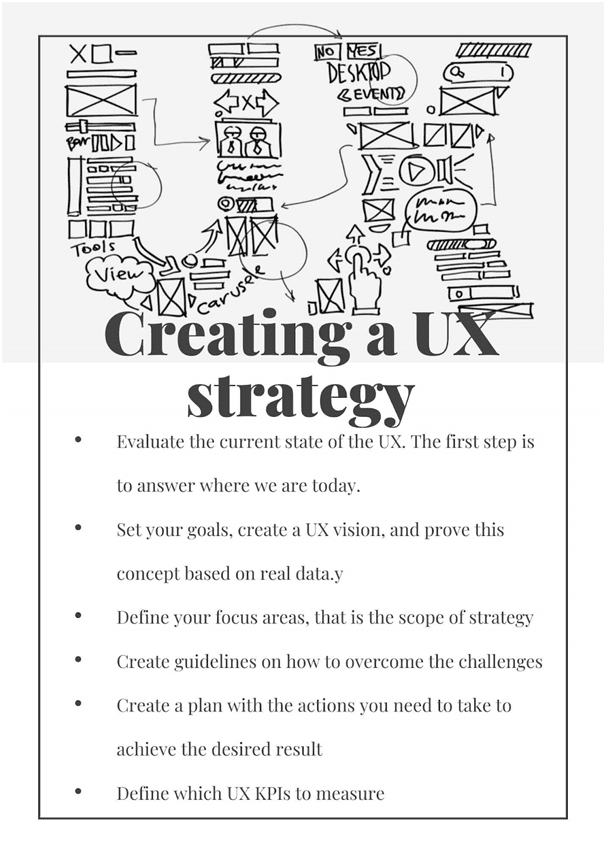We’re living in the era of experience, where it is already clear for everybody that a good user experience is a key to a successful product. However, “good experience” is not a set recipe. The ingredients to it have to be mixed individually for each case. That’s where tailored UX strategy comes to play.

So, what is a UX strategy?
UX strategy is a strategic planning process that takes into account not only the goals of the business but also the needs of the real consumers of the brand and connects each customer touchpoint with a user experience that the company intends to create.

Image credit: Sherif Amin
If you are struggling to grasp the difference between UX strategy and business strategy, think of it as the next step in the evolution of the product.
In old times, people had to focus on business goals. Later, they started paying more attention to users and their needs. Nowadays, user experience has grown to be so complex that it deserves a thorough strategic session to analyze the situation, develop guidelines, and build a plan.
How do you know if you need a UX strategy?
A strategist would say that it is better to have a strategy than not to have it. Yet, in the scarcity of startup resources, we have to prioritize, and UX strategy often does not score high on the list of to-dos.
When you are working on the prototype, keeping the features basic and design even more basic, UX strategy is not essential. However, when the product is out there and running, and the question of improving user experience is one of the most relevant, having a clear strategy is as important as having a working business plan.
When in doubt, make a strategy. It’s not as complicated as it may seem. Let’s go through the process of strategy development step by step.
How to build a UX strategy
The process of developing a UX strategy can be a matter of one session or take somewhere in between one session and forever. It is ok for strategy development to be a neverending process: once defined, it can be altered as the product grows, and research and metrics bring us new insights.
When building a UX strategy from scratch, it is best to follow these six steps:

1. Evaluation
Before going forward, we have to look back and around us. What is the current state of user experience? Was there any UX strategy previously? Was it successful? Is there a need for a new one?
Evaluation can be based on previous researches, reports, or the results of a UX audit. The important thing here is to be realistic. If the product has paid little attention to user experience so far, it is time to acknowledge it. If there was a certain system of UX management, it has to be taken into account even if designers prefer to build everything from zero.
2. Set the goals and define UX vision
After looking around, we have to decide where we are going. There is no “ideal” UX strategy that suits every product. Strategies have to serve specific goals, and defining goals is not as easy as it seems. This step is what helps to connect design to the business objectives.
While goals are more of a material side, the vision is the conceptual, intangible side. Sometimes defining the vision is no less difficult than setting the business goals.
The strategy is meant to bring the product to a new position. UX vision is the desired outcome: where do we want to get? How do we see our product in X months from now?
3. Find the right focus
A good strategy can not solve all the problems, and a good UX strategy can not make all the users happy. Choosing a focus for the strategy is what makes it efficient.
A focus can be set on one of the user personas if the business has many of them. In other cases, it can be a new feature that needs special attention and a strategy to be introduced to the users.
Don’t be afraid to set a narrow focus and “leave out” the rest: remember, the strategy is temporary, and the next direction will take a different focus.
4. Create guidelines
Guidelines are what make the UX vision more tangible. While the vision is more of a concept and is not easily applicable, the guidelines can be used by any team member for solving real problems.
In large teams, guidelines serve as a pitchfork for all the designers. However, in small teams with one or two designers, the guidelines are no less important. User experience depends not only on design, that is why guidelines would be helpful for all team members.
5. Plan
The overall strategy may seem quite an abstract document. What makes it real and efficient is the plan of action. The plan is developed based on the strategy and is the practical implementation of its basic principles.
The plan creates a tangible roadmap, which can be split into tasks. Concrete tasks with deadlines turn strategy into a working instrument instead of a written concept. A detailed plan is the secret of success (and not only in strategy).
6. Define UX KPIs
KPIs are directly related to the goals that were defined at the beginning, but when they are defined at the end of the process, you’d be surprised to find out that there is a certain difference between the two.
During the process of strategy development, it is important to find ways of measuring user experience even when it does not convert into numbers easily. Qualitative UX metrics are no less important than quantitative.
At this point, don’t forget to define the periods when the KPIs have to be measured. The average and convenient period is the monthly measurement, but it can be more often or rare depending on the dynamics of the project and KPIs themselves.
Conclusion
UX strategy sounds like a fancy instrument for the experienced teams who have their business plans set clear for the next 20 years. In reality, developing a strategy is not as complex as it may seem, and such an instrument can benefit a company of any size: from a tiny startup to a large enterprise. Having a UX strategy means being one step ahead in the long race of user experience excellence. When you don’t know where to start, start with a strategy: look around and think what direction you should be moving to.







